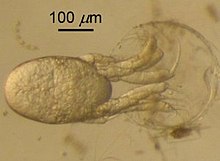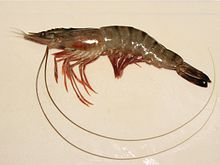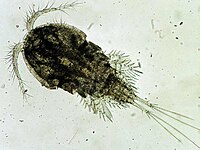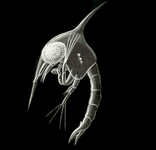Crustacean larva
Crustaceans may pass through a number of larval and immature stages between hatching from their eggs and reaching their adult form. Each of the stages is separated by a moult, in which the hard exoskeleton is shed to allow the animal to grow. The larvae of crustaceans often bear little resemblance to the adult, and there are still cases where it is not known what larvae will grow into what adults. This is especially true of crustaceans which live as benthic adults (on the sea bed), more-so than where the larvae are planktonic, and thereby easily caught.
Many crustacean larvae were not immediately recognised as larvae when they were discovered, and were described as new genera and species. The names of these genera have become generalised to cover specific larval stages across wide groups of crustaceans, such as zoea and nauplius. Other terms described forms which are only found in particular groups, such as the glaucothoe of hermit crabs, or the phyllosoma of slipper lobsters and spiny lobsters.
Life cycle
At its most complete, a crustacean's life cycle begins with an
Any organs which are absent from the adults do not generally appear in the larvae, although there are a few exceptions, such as the
History of the study of crustacean larva
Larval stages
Nauplius
The genus name Nauplius was published posthumously by
Zoea
The genus Zoea was initially described by Louis Augustin Guillaume Bosc in 1802 for an animal now known to be the larva of a crab.[1] The zoea stage (plural: zoeas or zoeae), only found in members of Malacostraca,[5] is characterised by the use of the thoracic appendages for swimming and a large dorsal spine.[5]
Post-larva
The post-larva or Megalopae, also found exclusively in the Malacostraca,[5] is characterised by the use of abdominal appendages (pleopods) for propulsion. The post-larva is usually similar to the adult form, and many names have been erected for this stage in different groups. William Elford Leach erected the genus Megalopa in 1813 for a post-larval crab; a copepod post-larva is called a copepodite; a barnacle post-larva is called a cypris; a shrimp post-larva is called a parva; a hermit crab post-larva is called a glaucothoe; a spiny lobster / furry lobsters post-larva is called a puerulus and a slipper lobster post-larva is called a nisto.
Larvae of crustacean groups
Branchiopoda
In the Branchiopoda, the offspring hatch as a nauplius or metanauplius larva.[6]
Cephalocarida
In the Mediterranean horseshoe shrimp Lightiella magdalenina, the young experience 15 stages following the nauplius, termed metanaupliar stages, and two juvenile stages, with each of the first six stages adding two trunk segments, and the last four segments being added singly.[7]
Remipedia
The larvae of
Malacostraca
Amphipod hatchlings resemble the adults.[9]
Young isopod crustaceans hatch directly into a manca stage, which is similar in appearance to the adult. The lack of a free-swimming larval form has led to high rates of endemism in isopods, but has also allowed them to colonise the land, in the form of the woodlice.
Stomatopoda
The larvae of many groups of
A single

Krill
The life cycle of krill is relatively well understood, although there are minor variations in detail from species to species. After hatching, the larvae go through several stages called nauplius, pseudometanauplius, metanauplius, calyptopsis and furcilia stages, each of which is sub-divided into several sub-stages. The pseudometanauplius stage is exclusive to the so-called "sac-spawners". Until the metanauplius stage, the larvae are reliant on the yolk reserves, but from the calyptopsis stage, they begin to feed on phytoplankton. During the furcilia stages, segments with pairs of swimmerets are added, beginning at the frontmost segments, with each new pair only becoming functional at the next moult. After the final furcilia stage, the krill resembles the adult.
Decapoda
Apart from the prawns of the suborder
The post-larva of shrimp is called parva, after the species Acanthephyra parva described by Henri Coutière, but which was later recognised as the larva of Acanthephyra purpurea.[12]
In the marine lobsters, there are three larval stages, all similar in appearance.

The larvae of the Achelata (slipper lobsters, spiny lobsters and furry lobsters) are unlike any other crustacean larvae. The larvae are known as phyllosoma, after the genus Phyllosoma erected by William Elford Leach in 1817. They are flattened and transparent, with long legs and eyes on long eyestalks. After passing through 8–10 phyllosoma stages, the larva undergoes "the most profound transformation at a single moult in the Decapoda", when it develops into the so-called puerulus stage, which is an immature form resembling the adult animal.[1]
The members of the traditional infraorder Thalassinidea can be divided into two groups on the basis of their larvae. According to Robert Gurney,[1] the "homarine group" comprises the families Axiidae and Callianassidae, while the "anomuran group" comprises the families Laomediidae and Upogebiidae. This split corresponds with the division later confirmed with molecular phylogenetics.[14]
Among the
Although they are classified as crabs, the larvae of Dromiacea are similar to those of the Anomura, which led many scientists to place dromiacean crabs in the Anomura, rather than with the other crabs. Apart from the Dromiacea, all crabs share a similar and distinctive larval form. The crab zoea has a slender, curved abdomen and a forked telson, but its most striking features are the long rostral and dorsal spines, sometimes augmented by further, lateral spines.[1] These spines can be many times longer than the body of the larva. Crab prezoea larvae have been found fossilised in the stomach contents of the Early Cretaceous bony fish Tharrhias.[15]
Copepoda
Copepods have six naupliar stages, followed by a stage called the copepodid, which has the same number of body segments and appendages in all copepods. The copepodid larva has two pairs of unsegmented swimming appendages, and an unsegmented "hind-body" comprising the thorax and the abdomen.[1] There are typically five copepodid stages, but parasitic copepods may stop after a single copepodid stage. Once the gonads develop, there are no further moults.[1]
Parasitic copepods

A, leg 3;
B, leg 3 (other specimen);
C, leg 4;
D, caudal ramus;
E, habitus of putative female, dorsal.
Scale bars: A–D = 0.025 mm; E = 0.2 mm.[16]
Chalimus (plural chalimi) is a stage of development of a copepod parasite of fish, such as the salmon louse (Lepeophtheirus salmonis).[17][18]
Chalimus Burmeister, 1834 is also a synonym for Lepeophtheirus Nordmann, 1832.
Facetotecta
The single genus in the Facetotecta, Hansenocaris, is only known from its larvae. They were first described by Christian Andreas Victor Hensen in 1887, and named "y-nauplia" by Hans Jacob Hansen, assuming them to be the larvae of barnacles.[19] The adults are presumed to be parasites of other animals.[20]
See also
References
- ^ a b c d e f g h i j k l m n o p q r Robert Gurney (1942). Larvae of decapod crustacea (PDF). London: Ray Society. pp. 1–306.
- ISBN 9780374251437.
- ^ Crustaceamorpha: Metamorphosis and Larvae - UCMP Berkeley
- ^ Key for the identification of crustacean nauplii - Academia.edu
- ^ a b c d "Crustaceamorpha: Metamorphosis and Larvae". ucmp.berkeley.edu. UC Museum of Paleontology (UCMP). Retrieved 22 August 2022.
- ^ Branchiopoda (Anostraca, Notostraca, Laevicaudata, Spinicaudata, Cyclestherida)
- S2CID 85246439.
- S2CID 11575617.
- Museum Victoria. Archived from the originalon September 18, 2010. Retrieved June 7, 2010.
- ^ S. T. Ahyong; J. K. Lowry. "Stomatopoda: Families". World Crustacea. Australian Museum. Archived from the original on December 14, 2010. Retrieved June 6, 2010.
- ^ Joachim T. Haug; Carolin Haug; Manfred Ehrlich (2008). "First fossil stomatopod larva (Arthropoda: Crustacea) and a new way of documenting Solnhofen fossils (Upper Jurassic, Southern Germany)" (PDF). Palaeodiversity. 1: 103–109.
- .
- .
- Raffles Bulletin of Zoology. Suppl. 21: 1–109. Archived from the original(PDF) on 2011-06-06.
- ^ John G. Maisey & Maria da Gloria P. de Carvalho (1995). "First records of fossil sergestid decapods and fossil brachyuran crab larvae (Arthropoda, Crustacea), with remarks on some supposed palaemonid fossils, from the Santana Formation (Aptian-Albian, NE Brazil)" (PDF). American Museum Novitates (3132): 1–20.
- PMID 23647664.

- ^ The salmon louse Lepeophtheirus salmonis (Copepoda: Caligidae) life cycle has only two chalimus stages. LA Hamre, C Eichner, CMA Caipang, ST Dalvin…, PLOS One, 2013
- ^ Ultrastructure of the frontal filament in chalimus larvae of Caligus elongatus and Lepeophtheirus salmonis from Atlantic salmon, Salmo salar. AW Pike, K Mackenzie, A Rowand, Pathogens of wild and farmed fish: sea lice, 1993
- S2CID 2943845.
- PMID 18598383.









